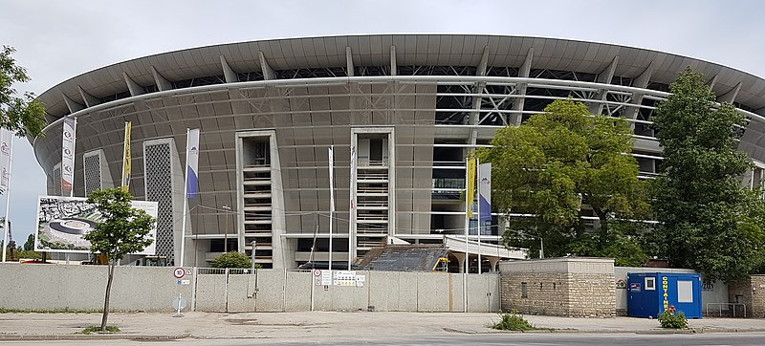
As is the case with most countries around the world, football is the most popular sport in Hungary. It is controlled by the Hungarian Football Federation, which was formed in 1901 and is responsible for organising the national team as well as the Hungarian football league.
The men’s national team made its competitive debut at the 1912 Summer Olympics, which is also the tournament that it has enjoyed the most success in over the years.
It has won three Gold medals in Summer Olympic tournaments, having not yet won either the World Cup nor the European Championship, despite entering both numerous times.
Football Stadiums In Hungary

Whilst it would be unfair to suggest that the sort of stadiums that you’d come across in Hungary are little better than League Two stadia, it’s certainly the case that you’re unlikely to find the kind of football ground that Premier League football fans will be used to. After all, only five of them have capacities larger than 15,000 and one of those is the national stadium.
Instead, the majority of grounds are smaller than 10,000 in capacity, with the smallest only having enough room for around 500 spectators. When it comes to the look of the grounds, most of them take after the original English look of having a stand on each side of the pitch. The more modern ones have a look that is now usual for European grounds of having a bowl style of continuous seating.
Whilst most of them are built to protect the crowd from poor weather, you’d be well-advised to take a big coat with you if you’re heading to watch a game when the weather isn’t all that warm.
Hungarian Leagues

As is common in Europe, the Hungarian football league system offers the promise of promotion to teams that do well and relegation to those that do not.
The Hungarian 1st Division is the top-flight, known as the OTP Bank Liga at the time of writing thanks to sponsorship.
It has 12 teams that play each other three times.
The champions enter the qualification period for the Champions League, with other teams finishing at the top end of the table entering the Europa League.
The bottom two clubs in the Nemzeti Bajnokság I are relegated to the Nemzeti Bajnokság II, which has 20 teams and the top two gain promotion.
The bottom two are relegated into the third tier of the Hungarian league system.
Things carry on from there in a similar fashion in terms of promotion and relegation, with the entire football league system having eight tiers to it.
Within those eight tiers there are hundreds of leagues containing thousands of football teams.
Hungarian National Team

The Hungarian national football team was formed in 1912 in order to take part in that summer’s Olympic Games. That was in spite of the fact that the country was technically part of the Austro-Hungarian Empire at the time. The two countries had always been separate when it came to sporting events, so there was no requirement to create a joint football team. In order to take part in the Olympics the side had to ask for donations, only for the players to lose 7-0 to England.
Hungary were one of six teams to take part in the Europa Cup, which is widely considered to be one of the first internationals tournaments. They played alongside Austria, Czechoslovakia, Switzerland, Russia and Yugoslavia, eventually losing to the Russian in the final. They did beat France 13-1 in 1927, though, which is still a record today. Hungary’s first taste of World Cup action came in 1934 and their first foray into the European Championship was in 1964.
At the time of writing, Hungary have not won either of the major tournaments that they’re entitled to take part in. They’ve come close a couple of times, though, finishing as runners-up in the World Cup in 1938 and 1954 and third in the 1964 European Championship. The country’s biggest football success has come in the Summer Olympics, winning it three times to date in 1952, 1964 and 1968. They were inspired by Ferenc Puskás, after whom the national stadium is named, as is the FIFA yearly award for the ‘best’ goal scored in a calendar year.
Key Stats
| Hungarian National Team Statistics | |
|---|---|
| Year Formed | 1912 |
| Home Stadium | Puskás Aréna |
| Stadium Capacity | 66,889 |
| Major Honours | Summer Olympics Gold Medal (1952, 1964, 1968) |
| Current Manager | Marco Rossi |
| Top Scorer | Ferenc Puskás (84) |
| Most Caps | Gábor Király, Balázs Dzsudzsák (108) |
| Best Performance at World Cup | Runners-Up (1938, 1954) |
| Best Performance at European Championships | Third Place (1964) |
| Kit Colours | Red, White, Green (Home), White with Red and Green (Away) |
History Of Football In Hungary
The Magyar Labdarúgó Szövetség, which is the Hungarian Football Federation, was formed in 1901, suggesting that the sport hasn’t been played in the country for as long as you might imagine. It didn’t take them long to get going, though, with the top-flight Nemzeti Bajnokság I being formed later in that year. It was contested between five different teams, which means that the sport was already popular enough for the clubs to have formed.
The team soon became a common fixture at the major tournaments, including the first ever Summer Olympics and the second World Cup. They became the first team from outside of the UK to defeat England at Wembley Stadium when a team led by Ferenc Puskás won 6-3 in 1953. He was one of the most influential figures in the game, helping the side to remain unbeaten from 32 games apart from the World Cup final in 1954.
